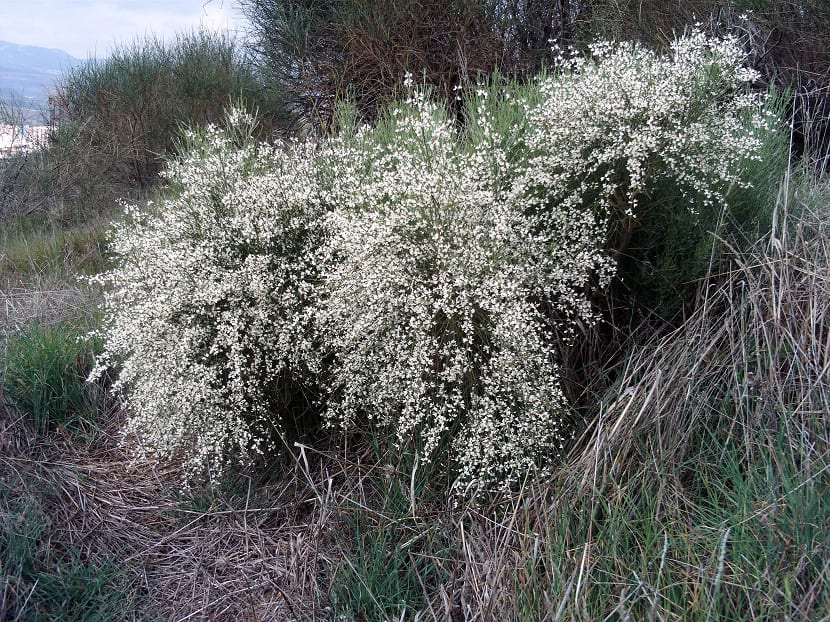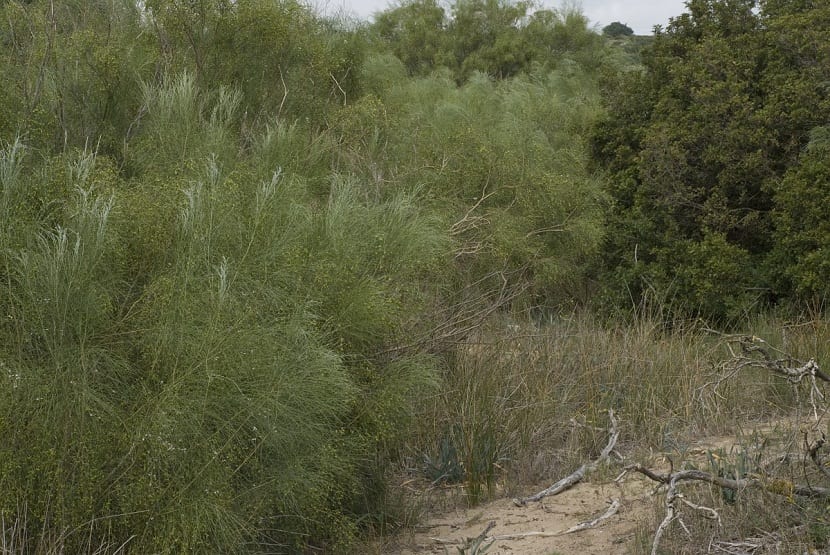
La Monosperm broom belongs to the genus Retama (more specifically to the Fabaceae family) and is characterized by its white flowers (that is precisely why its common name is white broom). It is a species of legume popularly known in the Iberian southwest and in the northwest of Morocco.
Features

La monosperm broom es a monoecious shrub whose height ranges between 3 meter and XNUMX meters. Its branches are junciform, green and striated throughout. Its leaves are alternate, uniform and whose leaflets are lanceolate or in other cases linear, lanceolate or silky-silvery.
As its common name indicates, its flowers are white in the shape of a butterfly and measure between 9 and 12 mm. Its flowering period takes place throughout the spring. They appear in the form of short lateral racemes and with a low amount of flowers. Its branches, on the other hand, are ribbed and vary in relation to the age of the plant, other important species being the Yellow broom or the Black broom.
In short, if we want to describe it in general lines to favor its recognition, we can say that it is a legume not less than 14 mm in height and no more than 18, dome or rounded, ending in a point, showing a color between brown and yellow and giving rise to 1 or 2 seeds.
Origin and habitat of the Monosperm broom
Species native to southern Europe, the White broom is used to living mainly by the sea, on soils rich in sand (in this sense, it should be noted that they support environments with a high level of salinity and are ideal for retaining mobile dunes). It is also suitable to be used for the recovery of slopes, both in rockery and in dry areas.
Its habitat is made up of juniper groves, juniper groves and pine groves of the mobile or semi-fixed coastal dunes. The White Broom requires, for its good growth, a plenty of sun exposure and it is not suitable to withstand frosts, it only does so if they are very infrequent and of low intensity.
Returning to the above, it is capable of developing in poor, sandy and saline soils. However, it is necessary to always remember that needs good drainage. In any case, they are strongly resistant to drought.

It should be watered moderately throughout the year, but it should be noted that it is always a requirement that the soil is well dry before watering again. On the other hand, its care is simple given the fact that it does not require special fertilizersbut only a small amount of organic matter every two years.
In turn, although it does not need to be pruned, you can do it after flowering with the sole objective of shaping it or eliminating branches that no longer serve (that is, those that are in poor condition due to the presence of deformations or they are either broken or damaged by the presence of the wind, etc.). This procedure, however, must be done very delicately. Pruning can also serve to prevent possible pests or diseases.
Finally, its multiplication is carried out by means of tip cuttings that are prepared during the autumn season, or from seeds (to these it is preferable, for a better result, to introduce them for about five seconds in very hot water or in other words, boiling, about five seconds before starting sowing).
Plagues and diseases
Although this plant, being country-style, it is very resistant to pests and diseases, is not immune to them, since aphids they usually attack them. This well-known pest is characterized by sucking the sap from the plant and leaving yellow specks on its leaves. This can be very damaging to the plant.
In addition, as a consequence of this condition, the bold can infect the broom. This fungus is also extremely harmful since, by covering the leaves with a thick substance similar to a powder, it blocks the fundamental process of every plant, through which it feeds: photosynthesis. If you want to eradicate these two pests, You must purchase both specific insecticides and copper products.
Uses
It was conceived from time immemorial as a “magic plant”, Although it was also used in a medicinal sense both to relieve fever and to treat respiratory problems. Long ago, its branches were also considered useful, they helped to raise the temperature of the oven or in the preparation of sweeping brooms (popular tradition in Galicia).
Care
This series of recommendations, which you will now understand better after knowing the generalities of the plant in the previous sections, will be very useful to ensure its growth and take care of its integral development.
First and foremost, you should not be scared, as its care is simple. However, taking into account climatic and environmental conditions is as essential for its development as it is for any other plant.

It is best placed outdoors, where it can receive large amounts of direct sunlight. If you choose semi-shade, it will only tolerate it for a short time, the more light it receives, the more it will bloom. However, this equation has a but, since you have to take care of the plant from high temperatures.
Although watering must be constant, not so abundant its quantity. You don't want to drown your broom! This can cause it to stop growing. Although it can be planted in a pot or indoors, it is ideal to grow it as an outdoor plant, since it is a wild species and as we have already said, the drainage must be good. However, here we must contribute that the soil also has to be sandy.
Now that you know everything about the white broom Are you ready to have one? Will you take care of all their care? Because being a responsible owner is not only used for animals ... Well, if you want it as decoration or for any other use, you must protect your Monosperm broom and make it grow strong and healthy.
Taking care of her is not only keep pests and diseases away from it, but also provide the best possible environmental conditions so that its development is harmonious and enjoyable. In this way, your broom will grow giving wonderful flowers that will decorate your garden. You will not want to miss this magnificent show!